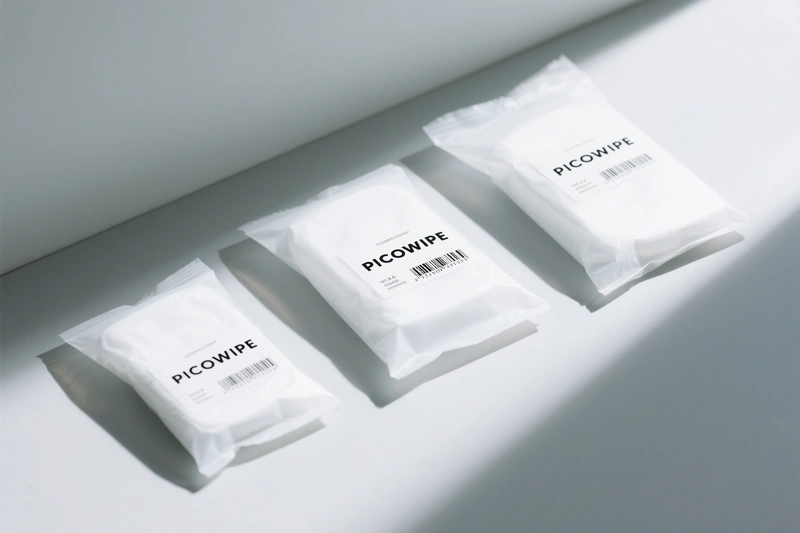By [email protected] — Charting the depths of expertise
In a cleanroom environment, cleanroom wipes are essential consumables for controlling contamination. However, a wipe's cleanliness depends not only on its material and washing process but also critically on its edge treatment—the sealing method. An improperly sealed edge can easily become a source of particle and fiber shedding. Therefore, when purchasing cleanroom wipes, it is vital to understand the principles, pros, cons, and applications of different sealing methods.
Common Edge Sealing Methods
Edge sealing for cleanroom wipes refers to the process of treating the edges after the fabric is cut to a specific size, locking in the fibers to prevent them from unraveling or shedding during use or washing. Currently, the main sealing methods are knife-cut, laser sealing, thermal cut, and ultrasonic sealing.
Knife-Cut: This method uses physical shearing force to cut the fabric. It provides no sealed edge.
Laser Sealing: A high-energy laser beam instantly melts and fuses the fabric, cutting and sealing the edge simultaneously.
Thermal Cut: A heated wire or blade is used for high-temperature cutting, causing the edge fibers to melt and bond together.
Ultrasonic Sealing: High-frequency ultrasonic vibrations generate frictional heat, which, combined with applied pressure, melts the fabric's edge to form a smooth, soft seal. Ultrasonic sealing is further divided into: ultrasonic narrow sealed edge, ultrasonic wide sealed edge, and ultrasonic wide patterned sealed edge.
Narrow sealed edges are typically <0.5cm. Wide sealed edges (wide flat edges) are typically ≥0.5cm. A wide patterned edge is created by pressing the fabric with a textured metal roller (which is the ultrasonic head). Depending on the roller's texture, a netted ultrasonic edge can be formed (imagine the head has countless raised points; pressing with these points creates a partially sealed edge that looks like a net).
Comparison of Sealing Methods
To visually understand the differences between the methods, the following table provides a comparison based on features, cost-effectiveness, and suitable applications:
| Sealing Type | Features | Cost-Effectiveness | Shedding Rate | Suitable Applications |
|---|---|---|---|---|
| Knife-Cut | No sealed edge, extremely high risk of fiber and particle shedding. Not launderable as it unravels easily. | ★★★★★★ | ★★★★★★ | Wiping and maintaining general equipment where cleanliness is not a high priority. |
| Laser | Strong and precise seal with a neat edge. However, the edge is hard (sintered block), may scratch sensitive surfaces, and can yellow. | ★★★★★ | ★★★★ | Meets most high-cleanliness requirements; suitable for non-sensitive surfaces like cleaning PCB circuit boards. |
| Thermal Cut | The seal balances firmness and softness with high cleanliness. However, improper process control can lead to jagged, yellowed, or wavy edges. | ★★★★ | ★★★★★ | Suitable for high-cleanliness applications, especially common for sealing the edges of cleanroom roll wipers. |
| Ultrasonic Narrow Sealed Edge | Seal is typically <0.5cm. The edge has relatively weaker tensile strength and may fray after washing. It is softer than a wide edge. The edge sheds few particles, and its cleanliness and softness are superior to laser and thermal methods, but it's more likely to fray after washing than they are. | ★★★ | ★★★ | Applications requiring extremely high cleanliness and surface protection, such as wiping precision, sensitive surfaces like semiconductor chips and optical lenses. |
| Ultrasonic Wide Sealed Edge | Seal is typically ≥0.5cm. Provides extremely high cleanliness (up to Class 10 standards), minimizing edge shedding. Will not fray after washing, but the edge is harder and can scratch products. It's generally used with the four edges folded in. | ★★ | ★ | Same as above. |
| Ultrasonic Wide Patterned Sealed Edge | Softer and less prone to fraying than a wide flat edge, but has a slightly higher shedding rate because some parts of the edge are not sealed by the ultrasonic press. | ★ | ★★ | Same as above. |
How to Choose a Sealing Method?
The core principle for choosing a sealing method is "match needs, balance performance." Consider the following angles:
Choose based on Cleanliness Class Requirements: Class 10 & 100 Cleanrooms: Prioritize ultrasonic sealing. Its extremely low shedding rate provides maximum contamination prevention. Class 1000 and higher Cleanrooms: Laser sealing or high-quality thermal cut offers a good balance of performance and cost-effectiveness. Non-Clean Areas or General Industry: If used only for general equipment maintenance with no strict shedding requirements, knife-cut cleanroom wipes are the most economical. Choose based on the Wiped Object's Sensitivity: Highly sensitive, scratch-prone surfaces: For optical lenses, wafers, precision coatings, etc., you must use the softest ultrasonic sealing to prevent permanent damage from a hard edge. Relatively durable surfaces: For PCB boards, equipment housing, etc., laser sealing or thermal cut can be used.
In short, there is no single best sealing method, only the one most suitable for a specific application. Before purchasing, clarify your cleanliness standards, the object you are wiping, and your budget. It's also best practice to test samples for particle shedding and abrasion resistance to make an informed choice.
PICOWIPE has mastered the full range of sealing processes, including knife-cut, laser, thermal, and ultrasonic. If you have any questions about selecting a method or its suitability for your application, please contact the PICOWIPE sales team for customized solutions and technical support.


